Taiwan's LED Lighting Industry Joins Forces
2009/10/07 | By Ken LiuTech-based efficiency gains and joint promotion of new applications has proven a winning combination for Taiwan's light emitting diode (LED) lighting industry, one that is adding up to an increasingly bright future.
Taiwan is currently the world's second largest supplier of LED lighting products by quantity, providing everything from epitaxy wafers and chips to packages and lighting modules. In each segment, manufacturers are tapping unique expertise to turn out niche products.
One promising development in the industry is the use of silicon-based materials by LED lighting packagers, whose products are used in lighting modules. Silicon has an excellent heat resistance, coefficient of thermal expansion (CTE) and transparency, making it well suited for lighting applications.
Some packagers underscore the excellent color rendering achieved by their products by using a full chromatic spectrum of phosphor powders. Others have expanded into the lighting-module design sector and are diversifying their product lines for different applications.
Collaboration in new product promotion is also gaining traction among Taiwanese LED manufacturers, who realize they can get more bang for their buck by integrating resources rather than going it alone.
MEMS Packaging
HELIO Optoelectronics Corp. is an LED packaging startup founded in 2006 by a team of optoelectronics specialists who formerly worked at the government-backed Industrial Technology Research Institute (ITRI). The company is working to integrate packaging with micro-electro-mechanical system (MEMS) technology, representing the fourth stage on the company's technology-development roadmap.
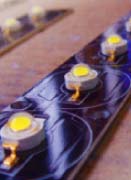
Chen was a former ITRI manger in charge of a wafer-level-packaging project. The technology enables IC packagers to encase system-on-chip (SoC) components directly on silicon wafers. "Our R&D team is mostly composed of MEMS specialists," he says.
Chen's company is testing MEMS integration in cooperation with a big-name silicon-chip assembler on the island. "We're planning to do the packaging on 200mm and 300mm silicon wafers and project to put out 2,000 3.4mm by 3.4mm packages on a wafer in our factory," he says. He estimates the company will begin volume production using the new packaging technology in one year.
So far, the company has tried lead-frame packaging, ceramic packaging and silicon packaging approaches, which mount LED chips on polymer-based substrate, ceramic substrate and silicon substrate, respectively. The first two approaches are used widely in the industry now, while silicon is gaining ground thanks to its advantages over other materials. For example, silicon melts at 1,000 centigrade, has a CTE below 4 ppm/C, and has a thermal conductivity (TC) in the range of 150-180 W/m.k.
HELIO also uses silicone rubber to encapsulate LED chip as a lens, and it is one of the few LED packagers good at silicone molding injection. According to Chen, the injection technology has considerably reduced the chance of lens bubbling and fissuring--a frequent problem when using conventional adhesive methods--enabling light to pass smoothly to the surface of the emitter.
As to the future market for silicon-based packaging materials, Chen notes that, "Silicon will win out over other materials because of its excellent performance and low cost."
The company has been focusing on high-power LED packages for lighting purposes since it was founded. Its product line includes 1-, 3-, 5-, and 10-watt emitters for general lighting, auxiliary lighting and auto lighting. Its 1W white emitters have an efficiency rating of 110 lumens per watt, and its 3W white emitters give off 180 lumens. The company sources chips from big-name suppliers, including BridgeLux of the United States, in which silicon foundry giant Taiwan Semiconductor Manufacturing Co. (TSMC) holds stakes.
Since its establishment, the company has won at least 42 patents, including a patent for AC LED packaging. The company's 40-person R&D team is formed by engineers with degrees in materials, mechanics, physics, optics, and biotech sciences. The company also has cooperated with elite schools in Taiwan, including National Sun Yat-sen University, National Central University, National University of Tainan and National Chiayi University on medical lighting and bio lighting. The company has also entered into alliance with end-product makers Coretronic Corp., and Foxsemicon Integrated Technology Inc., as well as LED chipmaker Optotech Corp.
HELIO has sold its packages to over 300 lighting-module suppliers, making it one of the top three suppliers of high-power LED packages in Taiwan. The company now puts out 1.2 million emitters and 200,000 modules a month, delivering an equal half of its outputs each to indoor lighting suppliers and outdoor lighting suppliers.
Chromatic Totality
Intematix Technology Center Corp., the Taiwan subsidiary of phosphor-technology powerhouse Intematix Corp. of the United States, is intensively pitching its phosphor powders to LED packagers doing business with indoor-lighting manufacturers. "As LED lighting products are increasingly entering the home, lighting color rendering has become a more crucial issue now than before, when outdoor lamps accounted for almost the entire LED lighting industry. Phosphor powder determines the rendering," stresses Dr. David Chen, director of the Taiwan subsidiary's sales and marketing division.
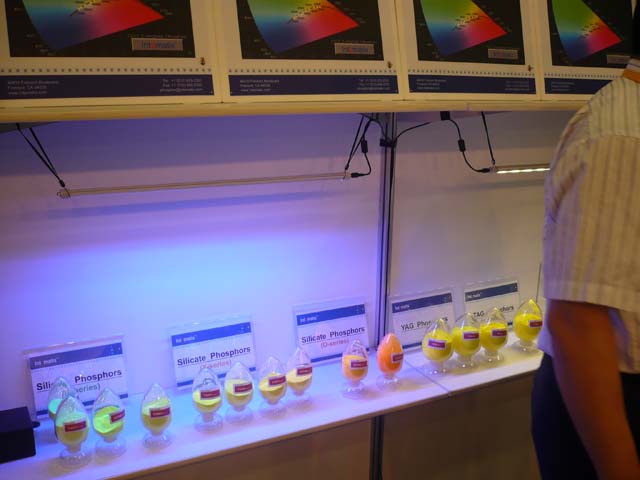
Nichia Corp. of Japan has been viewed as the world's No.1 supplier of LED phosphors. However, Dr. Yi-Qun Li, founder, chief technology officer and executive vice president of the Fremont, California-headquartered Intematix, says that Nichia lags far behind his company in terms of chromatic totality for commercialized phosphor powder. "We offer one color for every five nanometers on the spectrum. I think our product efficiency may even outstrip theirs," he says, stressing the company's technologies do not overlap Nichia's.
Intematix develops LED phosphor technologies and makes the powders in the United States. But its major market is the greater China region, home to the world's largest number of LED packagers, including the company's Taiwan subsidiary.
The company's powders post color temperatures ranging from 2,700K to 6,500K and deliver color rendering higher than 75, with silicate-based powder performing even higher than 90.
Li explains that the silicate-based approach to phosphor development provides a fundamental material advancement that allows Intematix's phosphor products to leapfrog past conventional YAG solutions in white-light efficiency.
According to Li, the silicate-based phosphor can be packaged with wide-ranging color chips, including ultraviolet and blue, to make high-efficiency white-light emitters for a variety of applications. "Silicate-based phosphors are known for efficient absorption of wide light wavelengths," he notes.
Focusing on Lighting
Genius Electronic Optical Co., Ltd. (GSEO) is Taiwan's second biggest optical-lens maker. Founded in 1990, the company has provided lenses for use on consumer electronics, such as mobile-phone cameras and notebook computers. More recently it expanded into the LED lighting field.
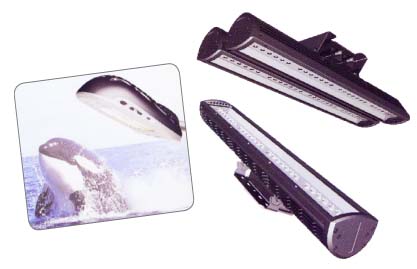
The company's LED-lighting operation has mostly focused on streetlights, which are rapidly converted to LED lamps with the aid of government energy-saving programs.
"Government contracts under stimulus programs are boosting demand for LED streetlights in the recession. We have delivered 3,000 lights under government contracts," says an unnamed sales executive at the company. He adds that mainland China is currently the fastest-growing market for LED streetlights. The company is closely watching the mainland's ambitious plan to install millions of LED streetlights as part of public-work projects in 21 major cities in the second half of this year.
The company is promoting its second-generation lights, which are sleeker than its more boxy first-generation products. The G901 family of lights is composed of 90W, 130W, 180W and 260W lights, with 90W and 130W each delivering 5,000 and 7,500 lumens of luminous flux and the other two delivering 10,000 and 15,000 lumens, respectively. The company's G003 line is made up of 155W and 60W streetlights, giving off 9,300 lumens and 5,700 lumens, respectively.
According to the sales executive, GSEO's streetlights meet Taiwan's CNS15233 standard for LED streetlights. "Tests have shown that our lights can withstand a wind force scale 17 and are qualified for the IP65," he says.
The company makes its lights with chips from Cree. The lights have achieved efficacy of 100 lumens per watt this year, up from 80 lumens per watt in 2008. Its eight-meter lights rated at 100 watts give off same amount of illumination as 250-watt mercury lights.
Recently, the company added washer lights and tunnel lights to its outdoor lighting line.
GSEO recently won a large contract from Philips for lens used on LED indoor lamps, a market that the company has initially tapped with a 25W light tube. The tube, specifically designed for office lighting, projects 205 lux of illumination to a distance of 1.5 meters and has a guaranteed lifespan of 30,000 hours. The tube is reportedly now available in Japan.
GSEO also sells an LED zoom-lens flashlight. The light is fitted into an aluminum-alloy wafer-proof body and projects a 1.5-lux beam up to 100 meters away. The flashlight has a guaranteed lifespan warranty of 10,000 hours.
Off the Street, Into the Kitchen
Everlight Electronics Co., Ltd., currently Taiwan's biggest LED packager, has recently added office light tubes, garden lights, fridge lights and AC LED emitters to its LED lighting LINE, which was previously dominated by streetlight products. "Our strategy is to make products for each high potential segment of the market," says Ken Liu, a marketing specialist at the company. The company supplies all of its products on ODM and OEM terms.
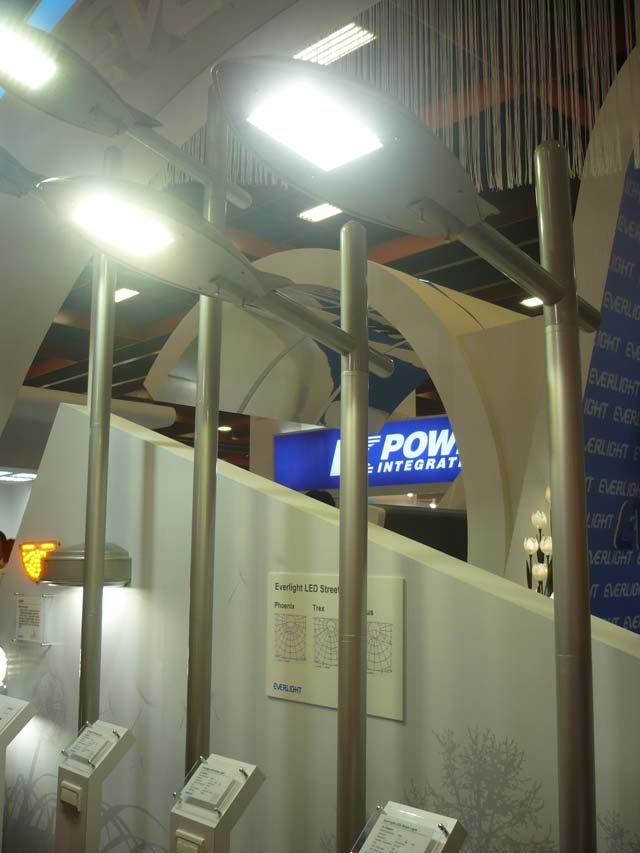
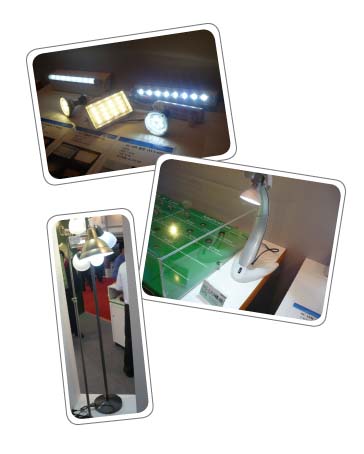
SL-Dolphin modules have an output of 75 lumens per watt at a height of eight meters and reduce energy consumption by 40% compared with mercury lights of similar specifications. The modules fit poles ranging from six to 12 meters in height.
Among the company's first office lighting products is its OL-Deluxe grid lighting fixture, which is outfitted with four 10W Everlight Cobra LED T5 tubes. The fixture delivers 2,880 lumens at over 70 lumens per watt. At a height of two meters, the lighting fixture projects 225 lux to the ground at a color temperature of 6,000 K.
Everlight's FT8 office lighting fixture comes with four T8 LED tubes that jointly produce 3,780 lumens of illumination. Efficacy is 50 lumens per watt, with 260 lux at a height of two meters from the ground and a color temperature of 6,500 K.
Everlight is a member of the alternating current (AC) LED alliance spearheaded by ITRI, which has transferred advanced LED technology to alliance members. The company has built the LED chips into indoor lighting fixtures including MR16, AR111 and Par Light fixtures. The company says AC LED is 20% more efficient than direct current (DC) lamps since there is no current conversion loss.
The company's lighting products are compliant with RoHS requirements.
While the recession has hit many industries, Liu thinks it could turn out to be a boon for LED lighting market. "The recession has made governments even more determined to carry out energy-conservation programs. And LED lights are an excellent energy-saving product," he notes.
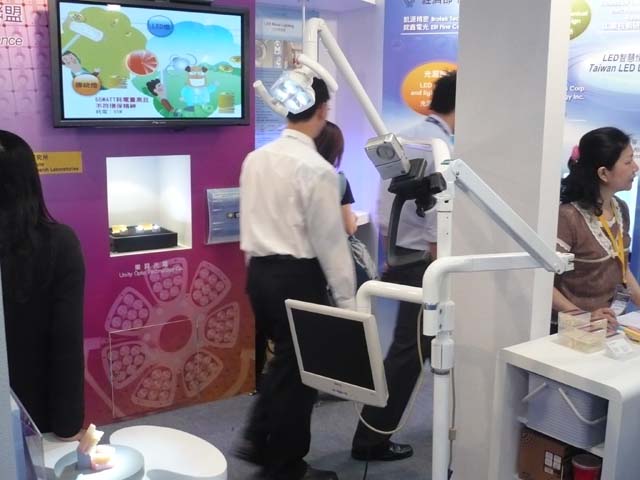
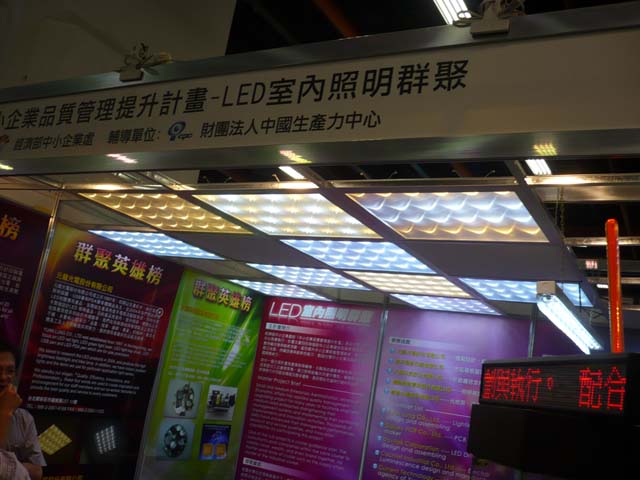
Everlight and 18 other Taiwanese manufacturers across the LED industry have formed a camp aimed at prompting AC LED lighting products. Among the other 18 members are chipmaker Epistar Inc. and consumer-electronics manufacturer Forward Electronics Co., Ltd., packager Lustrous International Technology Ltd. and thermal-solution provider Liquidleds Lighting Corp.
The alliance, which is backed by ITRI, has introduced at least 30 product applications, including desk lamps, floor lamps, bulbs, light tubes, lighting modules, and nightlights. An alliance representative says: "AC LED is an ideal solution for stationary LED lighting products ranging from desk lamps to streetlights."
According to James Chu, director of the Opto-Electronics Device and System Application Division (ODSAD) and leader of a project to develop AC LED technology, semiconductor devices have been designed to run on direct current electricity since day one, making them dependent on DC adapters plugged into household AC outlets.
"However, adaptor circuitry, as any other, has resistance and impedes around 30% of the current flow, compromising electrical efficiency. So the ideal design is to raise the current tolerance of LEDs so they can be directly powered by AC electricity," Chu says.
Chu points out that the alliance is working on industrial standards as well as developing applications. "As soon as we set an industrial format for AC LED, we can be free of the restraints posed by DC LED patents," he says.
LED grouping is also supported by the Small and Medium Enterprises Administration (SMEA) of the Ministry of Economic Affairs (MOEA). One of the teams aims at promoting the intelligent LED thematic lighting system and LED dental lighting system developed by ITRI.
Under contact by the SMEA, J.H. Chang, manager of ITRI's Technology Center for Service Industries, has brought together around 13 Taiwan-based manufacturers from all segments of the LED-lighting industry to form an alliance for the development of intelligent thematic lighting systems, which change light intensity and colors with the aid of computer programs. Chang hopes within four years to develop the technology to enable color and intensity changes via wireless remote.
"After surveying this sector for two years, I saw an excellent niche market that calls for a team effort," says Chang. He notes that the small-volume, high diversity production model in Taiwan is an asset in this market, one that few other countries can match. The lack of industry standards is another plus as Taiwan producers position to succeed in the emerging market. "World-class players also don't mind the rivalry for small-volume, big variety orders, which are simply too troublesome to fill," he adds.
LED lighting is also well suited for medical lighting systems, which require good color rendering, low shadowing, low temperatures and high luminosity. "Our medical lighting lessens shadows to only 45% to 60% at one meter compared to traditional lights, allowing doctors to see wounds more clearly. Also, such light emits no infrared light, minimizing heat-related problems during surgery. Good or natural color rendering allows doctors to better identify and examine pathogens," Chu says.
The medical lighting system gives off 9,000 lumens and is 20% more power efficient than traditional types, Chu adds.
Another major proponent of LED grouping is the government-backed China Productivity Center (CPC). The organization has recently organized six local manufacturers scattering in printed-circuit board (PCB), drive IC, LED-lighting system and metal-product sectors, including Yuan Lung Co., Ltd., Davitek Corp. and Galaxy PCB Co., Ltd.
According to Yuan Lung's general manager, Goosen Su, the camp began forming a year ago and aims to promote indoor lights for the domestic market in the initial stage. "Indoor LED lighting techniques are already mature, posing a lower entry threshold to new entrants," he says.
Su points out that industry grouping allows companies to integrate resources to achieve a shared aim. "Each member has its own profession, but without integration none can go any further in the LED lighting sector," Su stresses.
The alliance will first develop lights for uses in offices and classrooms. "LED lamps are ideal for indoor applications due to their slim profile, good color rendering and energy saving merits," Su notes.




